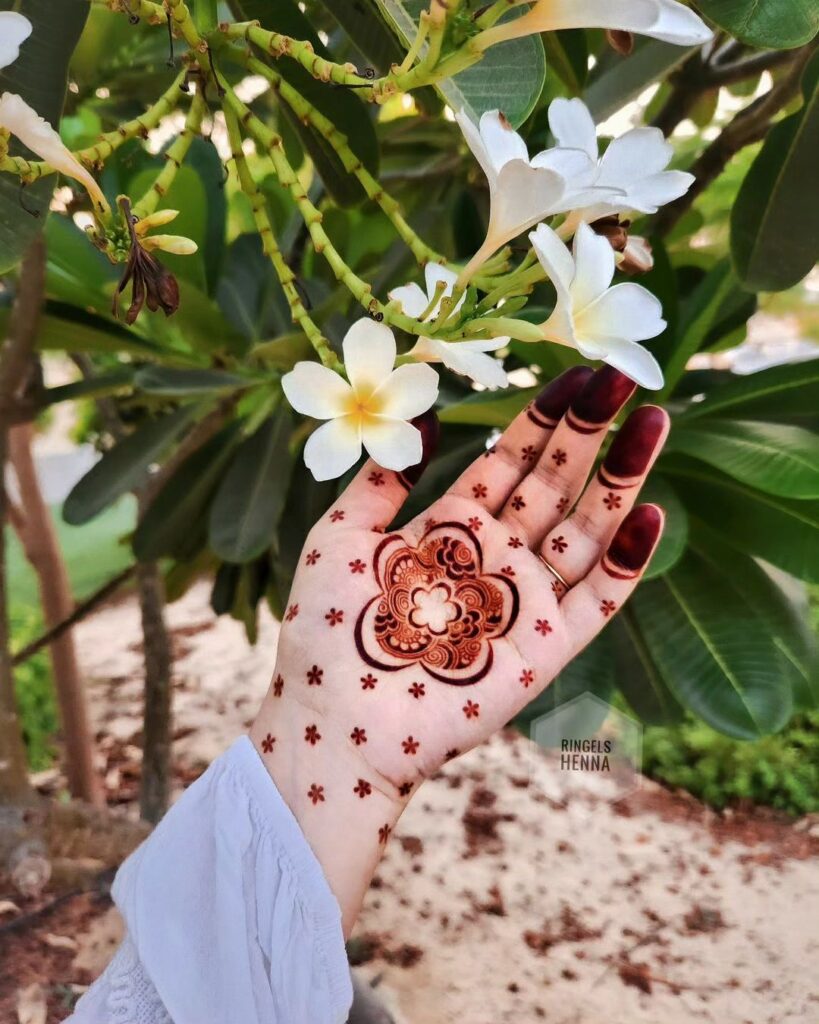Introduction to Arabic Mehndi Art
Arabic floral mehndi designs are a mesmerizing aspect of henna art, celebrated for their elegance, fluidity, and rich cultural significance. Rooted in Middle Eastern traditions, Arabic mehndi designs have become popular worldwide, captivating people with intricate floral motifs and flowing patterns that embody grace and femininity. Often applied during festivals, weddings, and other special occasions, these designs represent beauty, joy, and cultural heritage.
Characteristics of Arabic Floral Mehndi Design
Arabic mehndi is distinct for its bold and free-flowing patterns, primarily comprising floral themes, leafy vines, paisley shapes, and swirls. Unlike Indian mehndi, which covers the skin more densely, Arabic mehndi tends to be more open, with spacious designs that accentuate specific motifs. The unique aspects of Arabic floral mehndi designs include:
- Floral Motifs: Flowers are central in Arabic mehndi, symbolizing growth, elegance, and natural beauty. Each flower may vary in shape, ranging from simple blossoms to intricate, layered florals, often arranged to form eye-catching focal points on the hands, arms, or feet.
- Leaves and Vines: Leafy vines snake gracefully around the floral motifs, creating a fluid and harmonious look. These elements bring a natural touch to the design, allowing each pattern to blend seamlessly as if growing organically across the skin.
- Spacious Layouts: Arabic mehndi is known for its use of negative space, giving the designs an airy, sophisticated appearance. This spacious arrangement contrasts beautifully with denser designs, highlighting each detail and creating a balanced, graceful aesthetic.
- Flowing Lines and Borders: The curved, flowing lines and borders frame the floral motifs, enhancing the design’s elegance. These lines often extend outward, creating a delicate extension that adds continuity and flow to the pattern.
Cultural Significance and Modern Adaptations
Arabic floral mehndi designs are more than decorative art; they carry a deep cultural resonance. In traditional Arab culture, henna is used to celebrate joyous events, from weddings and religious festivities to personal milestones. The floral themes in these designs often represent love, fertility, and prosperity, adding a symbolic dimension to their aesthetic value.
Today, Arabic mehndi art has adapted to modern trends while preserving its essence. Artists incorporate contemporary elements like geometric shapes, shading techniques, and innovative placements (such as the back of the neck or shoulders) to appeal to a global audience.
Types of Arabic Floral Mehndi Designs
Arabic floral mehndi designs come in a range of styles, each with its unique appeal:
- Minimalistic Floral Designs: These simple, elegant designs feature fewer motifs and spacious layouts, ideal for those seeking subtlety and sophistication.
- Intricate Floral Patterns: Characterized by complex details, these designs often cover larger areas, such as the entire palm or arm, ideal for weddings or formal events.
- Half-Hand or Side Patterns: These designs adorn only half of the hand or specific sections, focusing on delicate floral arrangements and allowing more skin to show through for a modern look.
- Bridal Floral Mehndi: Bridal Arabic mehndi is grand and intricate, often incorporating multiple floral motifs, peacocks, or paisleys that extend from the fingertips to the forearm, creating an elaborate and captivating effect.
Tips for Creating Arabic Floral Mehndi Designs
For those interested in mastering Arabic floral mehndi designs, here are some tips to enhance creativity and technique:
- Practice Floral Detailing: Experiment with various flower shapes and sizes to create unique patterns.
- Focus on Fluidity: Practice drawing smooth lines and curves, as they are essential for achieving the flowing nature of Arabic designs.
- Balance Negative Space: Learn how to balance negative space within the design to highlight each motif effectively.
- Experiment with Shading: Shading techniques can add depth and realism, making the flowers appear more three-dimensional.
Here is “Beautiful Arabic Floral Art”


IMAGE SOURCE INSTAGRAM
